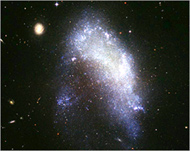Hubble’s main camera is back to work
The main camera on the Hubble Space Telescope came back to life on Friday for the first time in nearly two weeks after NASA engineers switched to a backup power system, the space agency announced.

The Advanced Camera for Surveys shut down June 19 after voltage readings exceeded the acceptable range. The switchover to the backup system began Thursday afternoon and was completed Friday morning, NASA said.
“This is the best possible news,” said Ed Ruitberg, deputy associate director for the Astrophysics Division at NASA’s Goddard Space Flight Center in Greenbelt.
“We were confident we could work through the camera issue, and now we can get back to doing more incredible science with the camera.”
The camera is scheduled to resume observations on Sunday night. Other instruments on the orbiting telescope have continued to operate during the outage.
A NASA board that met on Thursday to determine how to handle the camera’s power problem decided unanimously to switch to the redundant power supply, Ruitberg said.
Increased vision
 |
|
The ACS has increased 10 times |
The ACS camera, installed by a space shuttle crew in March 2002, increased Hubble’s vision 10 times and has given the clearest pictures yet of galaxies forming in the very early universe.
The instrument consists of three electronic cameras, filters and dispersers that detect light from the ultraviolet to the near infrared.
The power supply problem affected two of the three detectors.
If the switchover had not worked, engineers planned to look at each of the three detectors individually to try to isolate the problem, Ruitberg said.
Dave Leckrone, Hubble senior project scientist at Goddard, said the component that engineers believe was at fault “might be comparable to something like on your laptop computer, you have an adapter you plug into the wall and it provides the correct voltage to your power charger on your lap top. It’s something like that power adapter.”
Ultraviolet detector
|
“They’ve already sort of thought through this problem ahead of time, so that makes it very efficient for what we’re doing” Jennifer Wiseman, Hubble programme scientist at NASA |
One bright spot stemming from the outage is that it will allow engineers to recalibrate the ultraviolet detector to make it more sensitive, Leckrone said.
The instrument was developed jointly by Goddard, Johns Hopkins University, Ball Aerospace in Boulder, Colorado, and the Baltimore-based Space Telescope Science Institute, which coordinates use of the orbiting observatory.
Jennifer Wiseman, Hubble programme scientist at NASA headquarters, said the ongoing uncertainty over whether another shuttle servicing mission would be sent to the space telescope has forced Hubble scientists to work through how they would deal with such problems from the ground.
“They’ve already sort of thought through this problem ahead of time, so that makes it very efficient for what we’re doing,” Wiseman said.